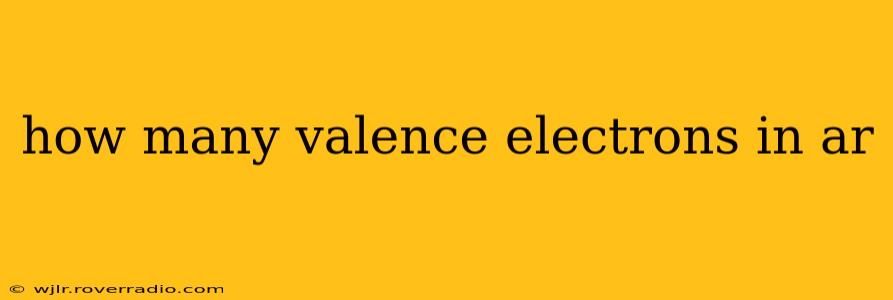How Many Valence Electrons Does Argon Have?
Argon (Ar), a noble gas, is renowned for its chemical inertness. This characteristic stems directly from its electron configuration and, specifically, the number of valence electrons it possesses. Understanding valence electrons is crucial to grasping an element's reactivity and its place within the periodic table. So, how many valence electrons does argon have? The answer is eight.
Let's delve deeper into why this is the case and explore some related concepts:
What are Valence Electrons?
Valence electrons are the electrons located in the outermost shell (also known as the valence shell) of an atom. These electrons are the ones most likely to participate in chemical bonding. Atoms tend to react in ways that achieve a stable electron configuration, often by gaining, losing, or sharing valence electrons to fill their outermost shell.
Argon's Electron Configuration
Argon's atomic number is 18, meaning it has 18 electrons. Its electron configuration is 1s²2s²2p⁶3s²3p⁶. This configuration signifies that:
- The first energy level (n=1) is filled with 2 electrons (1s²).
- The second energy level (n=2) is filled with 8 electrons (2s²2p⁶).
- The third energy level (n=3) is also filled with 8 electrons (3s²3p⁶).
Since the outermost shell (the third energy level) is completely filled with 8 electrons, argon has 8 valence electrons.
Why is Argon Inert?
The inertness of argon is a direct consequence of its full valence shell. Atoms with full valence shells are exceptionally stable because they have no tendency to gain, lose, or share electrons to achieve a more stable configuration. This is why argon rarely forms chemical compounds.
How Many Valence Electrons Do Other Noble Gases Have?
All noble gases (Helium, Neon, Argon, Krypton, Xenon, Radon, and Oganesson) have a full valence shell, making them chemically inert. While helium only has two valence electrons (due to its 1s² configuration), the rest, like argon, generally have eight. This octet rule, while having exceptions, is a fundamental principle in chemistry.
What Happens When Argon Interacts with Other Atoms?
While argon doesn't readily form chemical bonds, it can participate in weak van der Waals interactions with other atoms or molecules. These interactions are much weaker than covalent or ionic bonds and are primarily based on temporary fluctuations in electron distribution.
Can Argon Ever Lose or Gain Electrons?
While extremely unlikely under normal conditions, it's theoretically possible to ionize argon, meaning it could lose electrons. However, this would require a significant amount of energy and the resulting ion would be highly unstable. Gaining electrons is even less likely.
In summary, argon has eight valence electrons, a characteristic that dictates its chemical inertness and its position as a noble gas. This understanding of valence electrons is fundamental to comprehending chemical behavior and reactivity.
